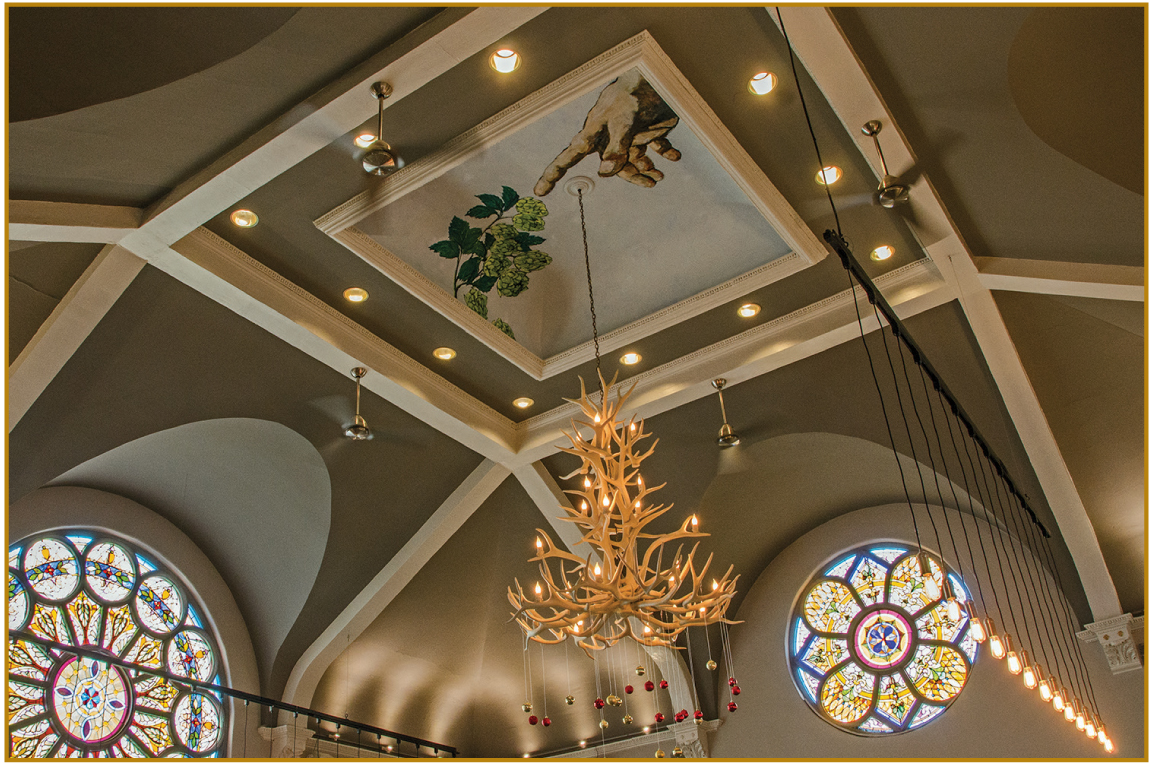

117 South Ann Arbor Street
Saline
734-295-9191
OWNERS: Ron Schofield and Mark Zadvinskis
BREWER: Ed Borsius
FLAGSHIP BEERS: Big Brown Bunny, an English porter; Boreal Forest, an American IPA; Crispy’s Tipple; Heavenly Hefeweizen; Kick Axe Kölsch

When Ron Schofield moved to Saline in 1990, one building immediately caught his eye: the church at the corner of Ann Arbor Street and East Henry Street. It was unlike anything else in this small town south of Ann Arbor. It was love at first sight.
The building, constructed in 1899, dominates the corner and the neighborhood. Its stone foundation, crenellated wall, and arches make the church look like a castle, and the brick steeple looks like the sentry tower of a fort. It is charming and intimidating at the same time, Schofield thought, and it would be a great place for a brewery.
Schofield had toyed with the idea of opening a brewery for twenty years—he even discussed it with his friend Ed Borsius, a home brewer. But he just couldn’t bring himself to think of it as a realistic goal. Finally, urged on by family and friends, Schofield began to seriously consider the opportunity, and he and Borsius looked at possible locations in and around Saline. Problem was, they didn’t see anything that excited them. The location of Schofield’s dreams wasn’t available. Even though the congregation moved to a new facility in 1990, the old church was occupied by a succession of businesses—a book and gift shop, a coffee shop and children’s play space, and finally a rental hall for parties and wedding receptions.

The ceiling at Salt Springs Brewery has been painted with a mural intended to evoke Michelangelo’s The Creation of Adam on the ceiling of the Sistine Chapel in Vatican City.
What Schofield didn’t know was that there was someone else in the area who also coveted the old church as a space for a brewery. That, surprisingly enough, was his neighbor, Mark Zadvinskis, who had moved to Saline from Ann Arbor just a couple of years earlier. One day in conversation, the two discovered they shared an interest in beer and a mutual love for a certain building. In fact, Zadvinskis had looked into buying the old church years earlier, but didn’t because the timing just wasn’t right.
Zadvinskis, Schofield, and Borsius decided to cast their lot together but agreed they would wait until they found the right place in or near downtown Saline. They did not want their brewery to be a storefront in a strip mall. They wanted to be a bigger part of the community, and the perfect place, they all agreed, would be the old church.
Then came the day when their real estate agent said the owners of the old church were thinking about retiring. Rather than wait for the building to come on the market, the three approached the owners with an offer. Time was of the essence because Zadvinskis, Schofield, and Borsius knew that other entrepreneurs were also nosing around town for space to open a brewery. If they hesitated for even a second it would be too late.

Salt Springs brewer Ed Borsius.
Once the papers were signed, the new owners spent five months on renovations. They put the kitchen in the old choir room, reinforced the old organ loft for seating, removed and replaced part of the floor with a concrete slab to support the fermenters, and overhauled sewers and water lines to meet the needs of the brewhouse in the basement.
Meanwhile, an eager community followed their progress through the newspaper and social media. People who walked in to check on the status of the brewpub often volunteered their services as laborers. And when a local painting company heard about the renovation, the owners donated their services just to be a part of the project.
The result was a beautiful brewpub. Stained glass windows on the south and west side filter the sunlight entering the pub and bathe the interior in pastels. The walls gently curve into the ceiling, and in the center of that ceiling is a painting of a hand with an extended index finger reaching or pointing to hops cones on a vine. The image is intended to evoke Michelangelo’s The Creation of Adam on the ceiling of the Sistine Chapel in Vatican City.
That description may make it sound as if Schofield and Zadvinskis are being irreverent, but the opposite would be true. The mural is intended to pay respect to the former church, life itself, and the creation of beer. The owners take pains to make sure that they are not being disrespectful to the former place of worship. They temper their pride with humility because they know that this building is special to people in the community; they frequently hear from customers who were baptized, married or used to worship in this space.
“Everybody working on the renovation gave a little bit more because they knew what this building was, what it was going to be, and what it meant to the community,” Schofield says.
Patience, it seems, has its virtues.